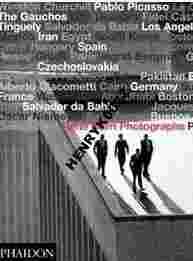Pub. Publisher: PHAIDON PRESS
Achieving initial recognition with the seminal photo-essay "Die Deutschen" in 1962, Rene Burri has maintained the vantage point of "unassuming reporter" throughout his career. His egalitarian approach to photography has allowed him access to many events and people who remain elusive to the rest of us. After joining the photo agency Magnum in the late 1950s, Burri travelled extensively around the world from the Middle East to South America and the breadth of his travels is fully represented in this comprehensive book. Included are key moments in Burri's career, such as his 1960s portraits of famous artists like Picasso, Giacometti and Le Corbusier which he took for "Du" magazine. It was around this same time that he took the photograph used for the now iconic poster of Che Guevara smoking a cigar. Since the 1960s, Burri photographed war zones such as Cambodia and Vietnam and made films for the BBC. A contemporary of Henri Cartier-Bresson, Burri takes photographs with a unique warmth and egalitarianism that distinguishes him from his peers. "Rene Burri Photographs" is the culmination of several years of scholarly research by Hans-Michael Koetzle into Burri's important contribution to reportage photography. The book begins with an introduction that describes the history, politics and artistic influences that have coloured Burri's work. Each of the 22 chapters that follow it is accompanied by a brief essay that gives an overview of the images in that particular section, the time period and political climate. Each page is also accompanied by extended captions explaining the images.body with the physical environment around her. Fascinated by transformation and the permeability of seemingly fixed boundaries, Woodman's work conjures the precarious moment between adolescence and adulthood, between presence and absence. This comprehensive monograph includes over 250 of Woodman's works - some of which have never been exhibited or published before - as well as extracts from her journals selected by her father George Woodman. There are examples of her large-scale blueprints and reproductions of her photobooks, including "Some Disordered Interior Geometries", which was published in 1981, the year she took her own life. An extensive text by Chris Townsend examines the influences of gothic literature, surrealism, feminism and post-minimalist art on Woodman's photographs. Townsend places Woodman in relation to her contemporaries, such as Cindy Sherman and Richard Prince. This book confirms Woodman's position as one of America's most talented photographers and important artists since 1970, with an influence lasting well beyond her own time. Interested in how people relate to space, and how the three-dimensional world can be reconciled with the two dimensions of the photographic image, Woodman played complex games of hide-and-seek with her camera. One of the enduring appeals of her work is the way in which she constructs enigmas that trap our gaze. She depicts herself seemingly fading into a flat plane, merging with the wall under the wallpaper, dissolving into the floor, or flattening herself behind glass. But is this disappearing act really the artist putting in an appearance? That we are never completely sure what we are looking at means that we keep looking. Woodman constantly compares the fragility of her own body with the physical environment around her. Fascinated by transformation and the permeability of seemingly fixed boundaries, Woodman's work conjures the precarious moment between adolescence and adulthood, between presence and absence.

